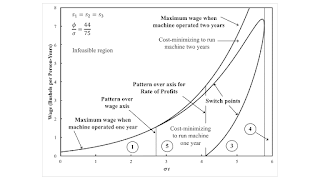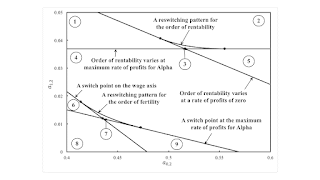Figure 1: Variation in the Economic Life of a Machine with Technical Progress Exploration of the effects of perturbations of model parameters in the analysis of the choice of technique has suggested an answer to this question to me. I am not sure how well-developed the argument in this post is. The question is raised by empirical results, particularly by Han & Schefold and by Zambelli. I have previous commented on Zambelli. Heinz Kurz has recently questioned the reliability of these results. The data come from economies in which fixed capital is widely used. One can expect old plants that would not be currently reproduced to be operated and to obtain quasi-rents. Nevertheless, empirical wage curves are surprisingly close to straight lines and reswitching and other 'perverse' phenomena
Topics:
Robert Vienneau considers the following as important:
This could be interesting, too:
Robert Vienneau writes Austrian Capital Theory And Triple-Switching In The Corn-Tractor Model
Mike Norman writes The Accursed Tariffs — NeilW
Mike Norman writes IRS has agreed to share migrants’ tax information with ICE
Mike Norman writes Trump’s “Liberation Day”: Another PR Gag, or Global Reorientation Turning Point? — Simplicius
| Figure 1: Variation in the Economic Life of a Machine with Technical Progress |
Exploration of the effects of perturbations of model parameters in the analysis of the choice of technique has suggested an answer to this question to me. I am not sure how well-developed the argument in this post is.
The question is raised by empirical results, particularly by Han & Schefold and by Zambelli. I have previous commented on Zambelli. Heinz Kurz has recently questioned the reliability of these results. The data come from economies in which fixed capital is widely used. One can expect old plants that would not be currently reproduced to be operated and to obtain quasi-rents. Nevertheless, empirical wage curves are surprisingly close to straight lines and reswitching and other 'perverse' phenomena seem to be rare.
Bertram Schefold took his empirical results seriously. He has been exploring what happens when the coefficients of input-output system are random in some sense. Reswitching is rare, but so is switching. For most of the range of feasible income distributions, one technique is dominant. If I recall correctly, he says this contrived problem. Most innovations replace one process with another, dominant process.
I get to the same result in another way. Figure 1 is from an example with fixed capital in which all coefficients of production decrease at an exponential rate. Reswitching occurs in Region 3. But that U-shape on its side is generic, in some sense. In models of the choice of technique with a single parameter varying or with parameters varying as a function of time, one will get the same sort of shape. Reswitching only occurs for a range of time. Before or after, no reswitching, at least of the same two techniques, occurs.
| Figure 2: A Part of a Parameter Space |
I also have considered how to partition parameter spaces based on fluke switch points. Figure 2 illustrates two parameters in a model of extensive rent. This example is written up in one of my publications. Regions 3 and 7 and their boundaries are also generic, in some sense. Reswitching occurs within these regions. The northeast boundary, in these cases, corresponds to a fluke switch point in which two wage curves are tangent at the switch point. Reswitching disappears over these boundaries.
These boundaries intersect, to the upper left, a boundary in which a fluke switch point occurs at a rate of profits of zero. At the intersection, the two wage curves are tangent at a rate of profits of zero. The reswitching pattern, on the other hand, intersects a boundary at the lower right at the maximum rate of profits. The region in which reswitching occurs can only be in a small part of the two-dimensional projection of the parameter space. Technical progress, in this example, is a movement from the upper right to the lower left in Figure 2.
I have been constructing or perturbing examples of 'perverse' phenomena. But the kind of structures outlined above are generic in some sense. I might think a bit about what regions with triple-switching and so on look like in the diagrams with two-dimensional projections of model parameters. It seems that technical progress is a matter of one technique becoming dominant, whatever the distribution of income. This change in dominance happens in secular time or in the very long-run. It is a matter of the wage frontier moving outward. Reswitching is a transient phenomenon, occurring in the long-run. I do not know how this impacts short-run dynamics or market prices.
References- Z. Han and B. Schefold (2006) An empirical investigation of paradoxes: reswitching and reverse capital deepening in capital theory", Cambridge Journal of Economics, V. 30: 737-765.
- Zambelli, Stefano. 2018. The aggregate production function is NOT neoclassical. Cambridge Journal of Economics 42: 383-426.
 Heterodox
Heterodox


